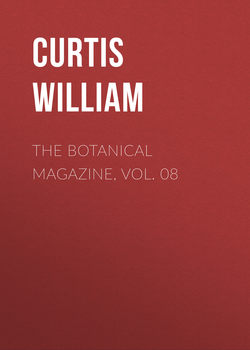Читать книгу The Botanical Magazine, Vol. 08 - Curtis William - Страница 7
[258]
Coronilla Varia. Purple Coronilla
ОглавлениеClass and Order
Diadelphia Decandria
Generic Character
Cal. 2-labiatus: 2/3: dentibus superioribus connatis. Vexillum vix alis longius. Legumen isthmis interceptum.
Specific Character and Synonyms
CORONILLA varia herbacea, leguminibus erectis teretibus torosis numerosis, foliolis plurimis glabris. Linn. Syst. Vegetab. ed. 14. Murr. p. 670. Ait. Kew. v. 3. p. 59.
SECURIDACA dumetorum major, flore vario, siliquis articulatis. Bauh. Pin. p. 349.
SECURIDACA II. altera species. Clus. Hist. 2. ccxxxvij. The greater joynted Hatchet Vetch. Park. Theat. p. 1088.
No258.
Clusius, in his work above referred to, informs us that he found this plant growing wild in various parts of Germany, in meadows, fields, and by road sides; that it flowered in June, sometimes the whole summer through, and ripened its seeds in July and August; the blossoms he found subject to much variation of colour, being either deep purple, whitish, or even wholly white: Casp. Bauhine notices another variety, in which the alæ are white and the rostrum purple; this variety, which we have had the honour to receive from the Earl of Egremont is the most desirable one to cultivate in gardens, as it is more ornamental than the one wholly purple, most commonly met with in the nurseries, and corresponds also better with its name of varia; it is to be noted however that this variety of colour exists only in the young blossoms.
The Coronilla varia is a hardy, perennial, herbaceous plant, climbing, if supported, to the height of four or five feet, otherwise spreading widely on the ground, and frequently injuring less robust plants growing near it; on this account, as well as from its having powerfully creeping roots whereby it greatly increases, though a pretty plant, and flowering during most of the summer, it is not to be introduced without caution, and is rather to be placed in the shrubbery, or outskirts of the garden, than in the flower border.
It will grow in any soil or situation, but blossoms and seeds most freely in a soil moderately dry.
Parkinson in his Theater of Plants, mentions its being cultivated, as an ornamental plant. Ait. Kew.
Its bitterness, will be an objection to its being cultivated for the use of cattle, for which purpose it has been recommended.
